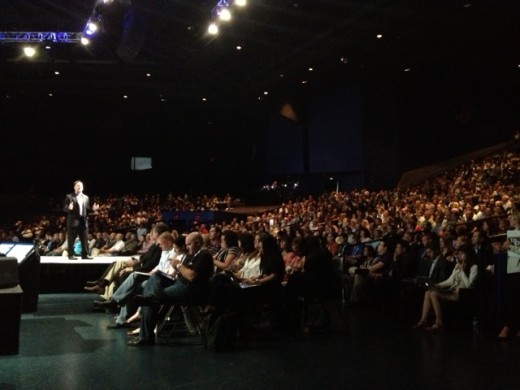How To Introduce A Keynote Speaker – Memorably and Intelligently

If you’ve poured in loads of hours organizing a fundraising dinner, you may be asked to introduce the keynote speaker. If you’ve donated a lot of money, you may be asked to introduce the keynote speaker. If you’re one of the most important guests in the audience, you may be asked to introduce the keynote speaker. The point? You weren’t picked to introduce the keynote speaker (necessarily) because you’re known for your speaking skills. And many articles out there on the Internet about this specific aspect of public speaking don’t help much, either. Here’s how you introduce a keynote speaker -- properly.
Please Don’t Screw This Up!
The introduction of the keynote speaker is a key part of the event – it is sort of what an appetizer is to a main course, and if you’ve ever gone to a fancy restaurant, you’ll understand that many times the appetizer sets the tone for the entire meal. It’s the first thing you eat and enjoy, and what you base your opinion of the restaurant on. Perhaps how you feel about the appetizer even trumps what you think of the main course.
You are supposed to set up the main speaker, to warm the audience to him or her. That person is sitting right there, listening to your introduction, worried secretly that you’ll pronounce their name correctly, that you’ll not embarrass them, that the audience will look forward to hearing from them. They are watching you do the introduction, yet what happens most of the time?
You give the introduction short shrift. Because you figured, “well, I’m just giving the introduction.” Most compose it 20 minutes before the dinner if they bother at all, or they read the biography from the program, word for word, to the audience. They don’t humanize the speaker at all. It’s sterile, boring, cold, and lifeless. The introduction typically begins horribly with something like, “our next speaker needs no introduction” and ends with something equally forgettable like “without further ado, I’d like to welcome so-and-so to the stage.” It’s awful.
As I’ve said many times in the past, the goal should be to make your audience like the keynote speaker as a human being. When I am in court, and I call witnesses to testify, I don’t have the luxury of giving a formal introduction and making the jury like my witness. But do you know what I do? I ask questions that make the witness talk about himself or herself in sympathetic terms. I don’t just ask their name and cut to the traffic accident testimony. No, I ask them what they do for a living, why they entered their profession, where they live, and how many kids they have. My hands are much more tied in court, but even those few questions make the jury sit up – no longer is this person just a witness in an accident; this person is now a mother of three from the local town, trying to make a living as a school teacher. In the same way, you need to humanize the keynote speaker, and here’s three ways how to do it:
Contact The Keynote Speaker in Advance
Most of the time, you are told way in advance that you are going to make the introduction. And do you know what I always do? I call them. I get them on the phone. First, you’ll be able to introduce yourself and at least get to chat and make them look forward to the event. If they look forward to the event, they’re more likely to think about it and prepare an even better speech than if you didn’t. But more importantly, a short, even two minute hello or conversation will give you material to speak about a person. During this two minute call, you can ask them about why they went into the field they did, or what they are currently working on. All this can be material for the introduction. The audience already knows what’s written in the program. What they want to hear, from eight rows back, is how it is to interact with the keynote speaker personally. And if you can give them that inside scoop (“when Dr. so-and-so talked, he was just coming back from Haiti, working on such-and-such”), and that will take your introduction to a higher level. If the keynote speaker is too busy, you can shoot them a quick email saying something to the effect of: “I am looking forward to introducing you to our dinner next week, and in reviewing your biography, I was curious…” and include one question they can respond to. That way, you can even read verbatim from the email and it will be something fresh. Please think outside the box on this.
One time, I was asked to introduce a judge at a law dinner. I spoke to the judge very briefly and noticed that he never really discussed his accomplishments, but instead was very interested what young lawyers were doing these days. That allowed me to say in the introduction that what’s remarkable about the judge was his incredible modesty and interest in young lawyers. That makes the introduction personal and unhinged from the cold resume, which is what you want.
Many times, you can even email or contact people the keynote speaker has touched in some way and ask them to send a quick email about them. If it’s a professor, you can email other professors or his or her students; if it’s a doctor, you can maybe see if the receptionist has some nice words to say. Either way, this is a good source of quotes or vouching that you can use to humanize the keynote speaker.

Tell a Story or Find a Theme about the Keynote Speaker
Most of the time, people who introduce the keynote speaker slavishly read from the biography or resume they’ve been given. This is just about the most awful thing you can do. It’s lazy and unoriginal. Instead, you can do one of two things. First, look at their accomplishments and figure out if you can see certain themes in the person’s history. Steve Jobs I think said something to the effect of – when you’re living your life, certain decision points don’t make sense, but when you turn back at the end of it all, you see how all the dots connected, and that can make for a wonderful story. Is the person someone who switched between the public and the private sector? Is this someone who’s in tension with what’s abroad and what’s happening here? Most careers have a narrative or an emotional center to them – find that center and talk about it in your introduction.
Second, you can search on the Internet for reputable sources and see what else happened. Often you can find writings or anecdotes or media stories that are not well-known but nevertheless encapsulate a speaker. Using this method, a friend of mine introduced an African American military hero by describing how that person was able to join the elite ranks of the military by writing to the president himself about racial inequality, and as a result being able to attend a school to join the military. Please remember to personalize the speaker – and don’t be afraid to talk about what you personally think of the speaker from reading about him or her – audiences love to hear about what you think, too. Don’t just give a bland fact-based intro that anyone else can give. Feel free to give your take also.
Why Should We Care About the Keynote Speaker?
This, surprisingly enough, is often the most neglected aspect of the introduction. Most people just say something like: “We’re lucky to have so-and-so with us tonight” and then launch into the dreaded resume-introduction. The keynote speaker then is left to flounder about and try to make his speech relevant to the event. Keep in mind that many events shoot for the highest-profile keynote speaker they can book, and sometimes the connection between the speaker and the event is a bit thin. So your job is to link and bridge the connection between what the speaker’s life is about and why he or she has something valuable to say about tonight’s event. Please remember to put that into your introduction as well.
Finally – I know we are all busy and sometimes it takes a lot of work to put the event together, or even to show up. Why put effort into the keynote introduction? “The glow of one warm thought is to me worth more than money.” Thomas Jefferson, one of the drafters of the Declaration of Independence wrote that a long time ago. America is a country of words and ideas. It has always been. And every opportunity that you and I have in this country to get together to exchange words and ideas – whether that’s in the court of law, or in a lecture hall, or at a banquet dinner – needs to be taken seriously. Your introduction of the keynote speaker sets the table for what could be a beautiful exchange of thoughts and ideas – it does not have to be done in a monotone as it is too often done. Put some thought into what you’ll say next time you’re introducing a speaker, and you’ll be amazed at what can happen.





